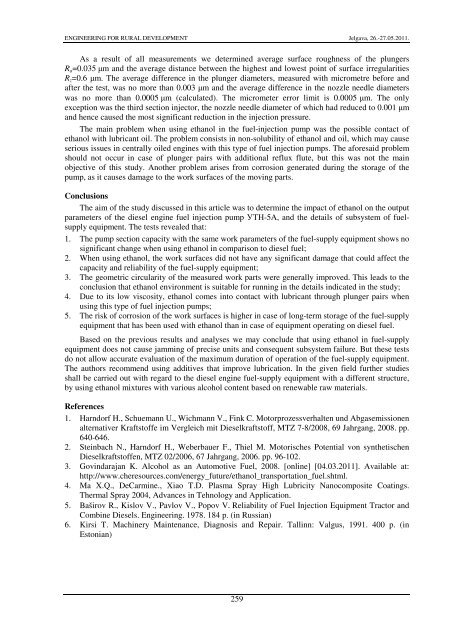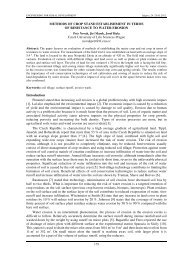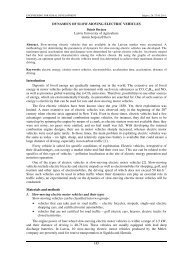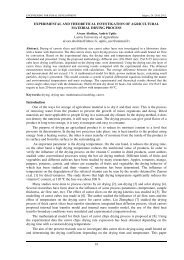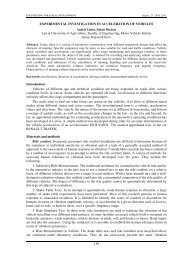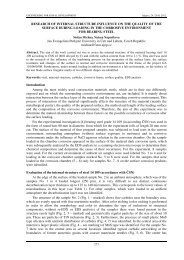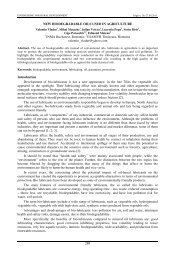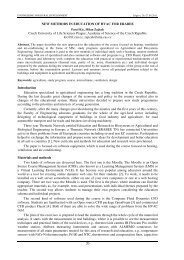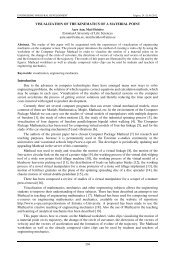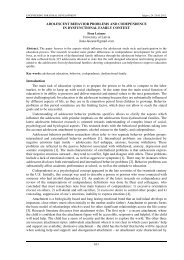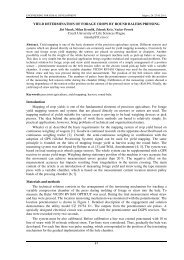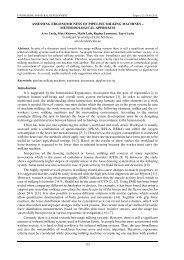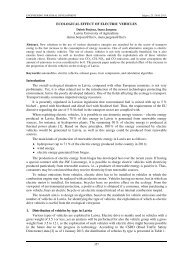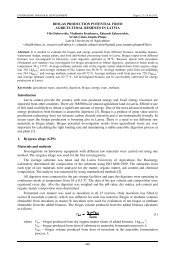impact of ethanol on fuel injection pump of diesel engine
impact of ethanol on fuel injection pump of diesel engine
impact of ethanol on fuel injection pump of diesel engine
- No tags were found...
You also want an ePaper? Increase the reach of your titles
YUMPU automatically turns print PDFs into web optimized ePapers that Google loves.
ENGINEERING FOR RURAL DEVELOPMENT Jelgava, 26.-27.05.2011.As a result <str<strong>on</strong>g>of</str<strong>on</strong>g> all measurements we determined average surface roughness <str<strong>on</strong>g>of</str<strong>on</strong>g> the plungersR a =0.035 µm and the average distance between the highest and lowest point <str<strong>on</strong>g>of</str<strong>on</strong>g> surface irregularitiesR z =0.6 µm. The average difference in the plunger diameters, measured with micrometre before andafter the test, was no more than 0.003 µm and the average difference in the nozzle needle diameterswas no more than 0.0005 µm (calculated). The micrometer error limit is 0.0005 µm. The <strong>on</strong>lyexcepti<strong>on</strong> was the third secti<strong>on</strong> injector, the nozzle needle diameter <str<strong>on</strong>g>of</str<strong>on</strong>g> which had reduced to 0.001 µmand hence caused the most significant reducti<strong>on</strong> in the injecti<strong>on</strong> pressure.The main problem when using <str<strong>on</strong>g>ethanol</str<strong>on</strong>g> in the <strong>fuel</strong>-injecti<strong>on</strong> <strong>pump</strong> was the possible c<strong>on</strong>tact <str<strong>on</strong>g>of</str<strong>on</strong>g><str<strong>on</strong>g>ethanol</str<strong>on</strong>g> with lubricant oil. The problem c<strong>on</strong>sists in n<strong>on</strong>-solubility <str<strong>on</strong>g>of</str<strong>on</strong>g> <str<strong>on</strong>g>ethanol</str<strong>on</strong>g> and oil, which may causeserious issues in centrally oiled <strong>engine</strong>s with this type <str<strong>on</strong>g>of</str<strong>on</strong>g> <strong>fuel</strong> injecti<strong>on</strong> <strong>pump</strong>s. The aforesaid problemshould not occur in case <str<strong>on</strong>g>of</str<strong>on</strong>g> plunger pairs with additi<strong>on</strong>al reflux flute, but this was not the mainobjective <str<strong>on</strong>g>of</str<strong>on</strong>g> this study. Another problem arises from corrosi<strong>on</strong> generated during the storage <str<strong>on</strong>g>of</str<strong>on</strong>g> the<strong>pump</strong>, as it causes damage to the work surfaces <str<strong>on</strong>g>of</str<strong>on</strong>g> the moving parts.C<strong>on</strong>clusi<strong>on</strong>sThe aim <str<strong>on</strong>g>of</str<strong>on</strong>g> the study discussed in this article was to determine the <str<strong>on</strong>g>impact</str<strong>on</strong>g> <str<strong>on</strong>g>of</str<strong>on</strong>g> <str<strong>on</strong>g>ethanol</str<strong>on</strong>g> <strong>on</strong> the outputparameters <str<strong>on</strong>g>of</str<strong>on</strong>g> the <strong>diesel</strong> <strong>engine</strong> <strong>fuel</strong> injecti<strong>on</strong> <strong>pump</strong> УТН-5A, and the details <str<strong>on</strong>g>of</str<strong>on</strong>g> subsystem <str<strong>on</strong>g>of</str<strong>on</strong>g> <strong>fuel</strong>supplyequipment. The tests revealed that:1. The <strong>pump</strong> secti<strong>on</strong> capacity with the same work parameters <str<strong>on</strong>g>of</str<strong>on</strong>g> the <strong>fuel</strong>-supply equipment shows nosignificant change when using <str<strong>on</strong>g>ethanol</str<strong>on</strong>g> in comparis<strong>on</strong> to <strong>diesel</strong> <strong>fuel</strong>;2. When using <str<strong>on</strong>g>ethanol</str<strong>on</strong>g>, the work surfaces did not have any significant damage that could affect thecapacity and reliability <str<strong>on</strong>g>of</str<strong>on</strong>g> the <strong>fuel</strong>-supply equipment;3. The geometric circularity <str<strong>on</strong>g>of</str<strong>on</strong>g> the measured work parts were generally improved. This leads to thec<strong>on</strong>clusi<strong>on</strong> that <str<strong>on</strong>g>ethanol</str<strong>on</strong>g> envir<strong>on</strong>ment is suitable for running in the details indicated in the study;4. Due to its low viscosity, <str<strong>on</strong>g>ethanol</str<strong>on</strong>g> comes into c<strong>on</strong>tact with lubricant through plunger pairs whenusing this type <str<strong>on</strong>g>of</str<strong>on</strong>g> <strong>fuel</strong> injecti<strong>on</strong> <strong>pump</strong>s;5. The risk <str<strong>on</strong>g>of</str<strong>on</strong>g> corrosi<strong>on</strong> <str<strong>on</strong>g>of</str<strong>on</strong>g> the work surfaces is higher in case <str<strong>on</strong>g>of</str<strong>on</strong>g> l<strong>on</strong>g-term storage <str<strong>on</strong>g>of</str<strong>on</strong>g> the <strong>fuel</strong>-supplyequipment that has been used with <str<strong>on</strong>g>ethanol</str<strong>on</strong>g> than in case <str<strong>on</strong>g>of</str<strong>on</strong>g> equipment operating <strong>on</strong> <strong>diesel</strong> <strong>fuel</strong>.Based <strong>on</strong> the previous results and analyses we may c<strong>on</strong>clude that using <str<strong>on</strong>g>ethanol</str<strong>on</strong>g> in <strong>fuel</strong>-supplyequipment does not cause jamming <str<strong>on</strong>g>of</str<strong>on</strong>g> precise units and c<strong>on</strong>sequent subsystem failure. But these testsdo not allow accurate evaluati<strong>on</strong> <str<strong>on</strong>g>of</str<strong>on</strong>g> the maximum durati<strong>on</strong> <str<strong>on</strong>g>of</str<strong>on</strong>g> operati<strong>on</strong> <str<strong>on</strong>g>of</str<strong>on</strong>g> the <strong>fuel</strong>-supply equipment.The authors recommend using additives that improve lubricati<strong>on</strong>. In the given field further studiesshall be carried out with regard to the <strong>diesel</strong> <strong>engine</strong> <strong>fuel</strong>-supply equipment with a different structure,by using <str<strong>on</strong>g>ethanol</str<strong>on</strong>g> mixtures with various alcohol c<strong>on</strong>tent based <strong>on</strong> renewable raw materials.References1. Harndorf H., Schuemann U., Wichmann V., Fink C. Motorprozessverhalten und Abgasemissi<strong>on</strong>enalternativer Kraftst<str<strong>on</strong>g>of</str<strong>on</strong>g>fe im Vergleich mit Dieselkraftst<str<strong>on</strong>g>of</str<strong>on</strong>g>f, MTZ 7-8/2008, 69 Jahrgang, 2008. pp.640-646.2. Steinbach N., Harndorf H., Weberbauer F., Thiel M. Motorisches Potential v<strong>on</strong> synthetischenDieselkraftst<str<strong>on</strong>g>of</str<strong>on</strong>g>fen, MTZ 02/2006, 67 Jahrgang, 2006. pp. 96-102.3. Govindarajan K. Alcohol as an Automotive Fuel, 2008. [<strong>on</strong>line] [04.03.2011]. Available at:http://www.cheresources.com/energy_future/<str<strong>on</strong>g>ethanol</str<strong>on</strong>g>_transportati<strong>on</strong>_<strong>fuel</strong>.shtml.4. Ma X.Q., DeCarmine., Xiao T.D. Plasma Spray High Lubricity Nanocomposite Coatings.Thermal Spray 2004, Advances in Tehnology and Applicati<strong>on</strong>.5. Baširov R., Kislov V., Pavlov V., Popov V. Reliability <str<strong>on</strong>g>of</str<strong>on</strong>g> Fuel Injecti<strong>on</strong> Equipment Tractor andCombine Diesels. Engineering. 1978. 184 p. (in Russian)6. Kirsi T. Machinery Maintenance, Diagnosis and Repair. Tallinn: Valgus, 1991. 400 p. (inEst<strong>on</strong>ian)259


